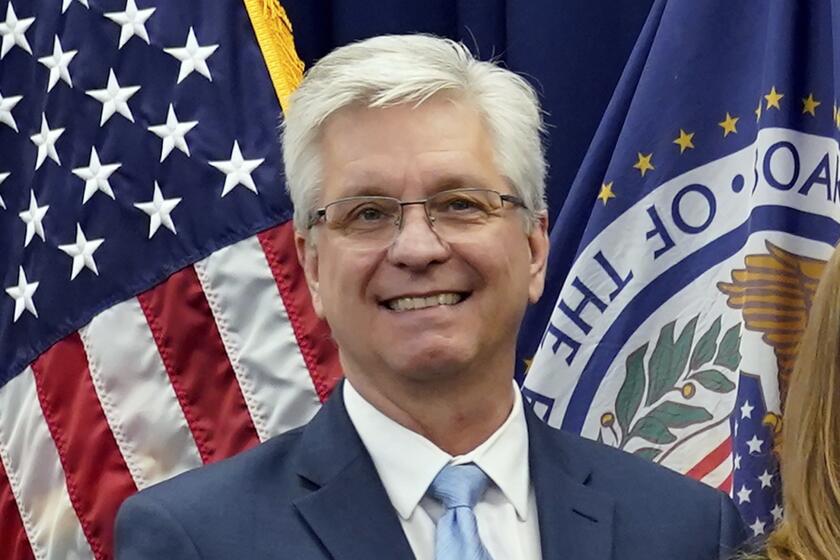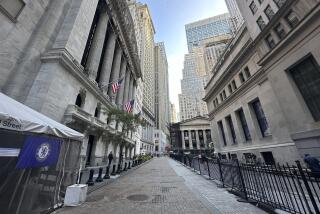Stocks tumble on fears about faster rate hikes; Dow falls 574 points

- Share via
Stocks sank Tuesday after the head of the Federal Reserve warned it could turn the dial back up on its hikes to interest rates if pressure stays high on inflation. The warning shook markets and raised worries about a possible recession down the line.
The Standard & Poor’s 500 index dropped 1.5% for one of its worst days of the year. The Dow Jones industrial average lost 1.7%, while the Nasdaq composite fell 1.2%.
Inflation and what the Fed is doing about it have been at the center of Wall Street’s wild actions this year. After seeming to be on a steady decline since peaking last summer, reports on inflation last month came in surprisingly hot. So did a suite of other data on the economy, including the job market and spending by U.S. consumers.
That raised fears on Wall Street that the Fed will continue to raise interest rates more aggressively. Higher rates can tamp down inflation because they slow the economy, but they also hurt prices for stocks and other investments. They also can raise the risk of a recession later.
The Fed’s chair, Jerome H. Powell, on Tuesday confirmed some of those fears and said that the recent data mean “the ultimate level of interest rates is likely to be higher than previously anticipated.” He also said in his testimony to a Senate committee that the Fed is ready to increase the pace of its hikes again if needed.
A run of strong economic data and signs that inflation remains stubbornly high could lead the Federal Reserve to raise its benchmark rate higher in the coming months than it has previously forecast, several Fed officials say.
That would be a sharp turnaround after it had just slowed its pace of increases to 0.25 percentage points last month from earlier hikes of 0.50 and 0.75 points.
“If the totality of the data were to indicate that faster tightening is warranted, we would be prepared to increase the pace of rate hikes,” Powell said. “Restoring price stability will likely require that we maintain a restrictive stance of monetary policy for some time.”
After sitting at virtually unchanged levels just before Powell’s testimony, stocks fell immediately afterward.
“This is the market coming back to realistic expectations,” said Megan Horneman, chief investment officer at Verdence Capital Advisors. ”I think it’s going to continue to wash out some of the excesses in the market.”
Wall Street had already begun convincing itself that higher rates than earlier thought were on the way and that the Fed may even possibly go back to larger rate increases following last month’s data reports.
Since getting last month’s blowout jobs report and other surprisingly strong data, Wall Street has largely abandoned hopes that percolated early this year for a possible cut to interest rates later in 2023. It also upped its forecast for how high the Fed will ultimately take rates before pausing.
That’s been most clear in the bond market, where the yield on the 10-year Treasury topped 4% last week and hit its highest level since November. It helps set rates for mortgages and other important loans.
On Tuesday, it again approached 4% after Powell’s comments before falling back to 3.97% from 3.96% late Monday.
A majority of the nation’s business economists expect a U.S. recession to begin later this year than they had previously forecast, after a series of reports have pointed to a surprisingly resilient economy despite steadily higher interest rates.
The two-year Treasury yield, which moves more on expectations for the Fed, shot up to 5.01% from 4.87% and is at its highest level since 2007.
Traders now see a better than 2-in-3 chance that the Fed will accelerate its rate hikes and raise its benchmark rate by 0.50 percentage points March 22. That’s a flip-flop from a day earlier, when the widespread bet was for the Fed to stick with a smaller increase of 0.25 points, according to data from CME Group.
“If they were to go 75 [basis points] after pulling back to 25, that would spook the markets,” Horneman said. “I still think that they’re going to go 25, but if they go 50, I think it” would be seen as the Fed’s “being very flexible and can act quickly if needed if economic data tells them that.”
“If they articulate that, I think markets can accept that.”
More fireworks may arrive later this week and into next as the Fed gets more data that will help shape its decision making ahead of its next meeting on interest rates.
On Friday will come the U.S. government’s monthly jobs report. Within that, most of the attention will be on how high wages are going for workers. The fear at the Fed is that too-strong gains could lead to more upward pressure on inflation.
Then two reports next week will give updates on how high inflation remains at both the consumer and the wholesale levels.
The challenge for the market has been that the economy has actually been too strong, despite all the rate increases the Fed has thrown at it. Although that resilience calms worries that a recession may hit imminently, it probably means rates will need to stay higher for longer. That in turn raises the risk of a deeper recession down the line.
The big shifts among investors about where inflation and the Fed are heading have led to sharp movements for markets. In January, stocks rallied and bond yields eased as hope blossomed that inflation would cool and get the Fed to take it easier on interest rates. Then, last month’s torrent of strong data dashed those expectations and sent stocks falling and bond yields jumping.
All told, the S&P 500 fell 62.05 points Tuesday to 3,986.37. The Dow lost 574.98 points to 32,856.46, and the Nasdaq sank 145.40 points to 11,530.33.
One outlier was WW International, which is better known as WeightWatchers. It soared 79.1% after saying it’s getting into the prescription weight loss business with the purchase of telehealth platform Sequence.
AP writers Yuri Kageyama and Matt Ott contributed to this report.
More to Read
Inside the business of entertainment
The Wide Shot brings you news, analysis and insights on everything from streaming wars to production — and what it all means for the future.
You may occasionally receive promotional content from the Los Angeles Times.












